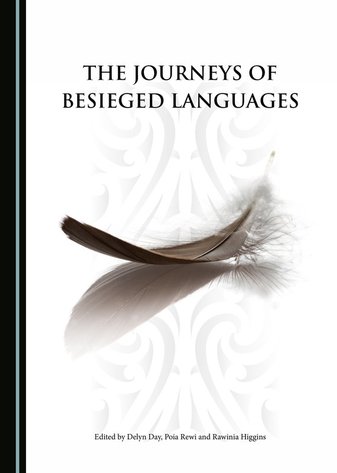6/27/2017 - Flaxflower

The Journeys of Besieged Languages
Delyn Day, Poia Rewi, Rawinia Higgins (eds)
This is a collection of papers by people, mostly academics, who have a strong interest in the reclamation and revival of endangered languages.
Delyn Day, Poia Rewi, Rawinia Higgins (eds)
This is a collection of papers by people, mostly academics, who have a strong interest in the reclamation and revival of endangered languages.
Written in a variety of styles, from the recounting of personal experiences through to highly technical analyses, the overall result is a fascinating picture of the major concerns surrounding threatened languages, and includes compelling arguments for continuing and expanding the efforts to rejuvenate them, ways of assessing the dangers they face, and suggestions and illustrations of what has succeeded and what hasn’t.
In a short review it is impossible to do full justice to all of the contributions, which collectively cover Swampy Cree and Anishinaabe (languages of the First Nation peoples of North America), Hawaiian, Tahitian, Māori, Barngarla (Eyre Peninsula in South Australia), Hebrew, Piedmontese, Romani, Kashubian (Poland), Kernewek (Cornish), Welsh, Gaelic and Kalaallisut (Greenland); but underlying all the papers is the assumption that language is an integral part of the world view of the various cultures as well as being essential to the proper functioning of human relationships within them. The survival of these languages, therefore, is deemed vital to the well-being of individuals, groups, nations and humanity as a whole.
There are examples of astonishing successes, such as that achieved through Whatarangi Winiata’s Whakatupuranga Rua Mano, Generation 2000 plan in Otaki, related by Mereana Selby, and of painful difficulties, such as Kaiwipunikauikawēkiu Lipe’s personal struggles to continue using Hawaiian with her children in the face of the relentlessly pervasive and privileged influence of English. Bernard Spolsky demonstrates how much can be achieved with the full backing of the State, when he explains how Hebrew was successfully established as the everyday language of Israel, to the point where it is now fully revived from the centuries when it had been used only in religious ceremonies and as the language of religious texts.
To select just one other of the many thought-provoking issues raised: a distinction is made between a society in which there are two main languages one of which is privileged while the other is treated as being of lower status, and a society in which both main languages are given equal value and where bilingualism is actively encouraged. The former situation is termed here ‘diglossia’. An excellent exposition of the importance of avoiding diglossia is given in Jeremy Evas’s contribution on the Welsh language situation.
This also relates directly to the question of whether or not those from outside should be encouraged, or even permitted, to learn the language of the group. In his article on Romani, Ian Hancock points out that the speakers of this language have long been reluctant to allow others to learn and use it. This same reluctance is sometimes also to be found amongst other language groups, but it is obvious that some degree of bi- or multilingualism is the only way that true understanding between different language/cultural groups can be attained, and the benefits of different world views shared. As Jeremy Evas writes, quoting a European Commission communiquė of 2008, “Multilingual people are a precious asset because they act as the glue between different cultures.” Even the most irredeemably monoglot English speaker in Aotearoa-New Zealand should at least sincerely wish he or she could speak Māori, as Māori culture is a major part of what defines us and makes us unique.
The design and production of the book does not quite match the quality of the contributions. The maps are not always as clear as they might be. Then there is the confusing use of the em-dash without spacing. This reviewer kept seeing hyphenated words rather than punctuation marks. But much more irritating were the large blank spaces where two of the explanatory charts should have been.
Setting that aside, this book is an accessible and absorbing contribution to a very topical issue, and it should be of considerable interest to both the general reader and the specialist.
Setting that aside, this book is an accessible and absorbing contribution to a very topical issue, and it should be of considerable interest to both the general reader and the specialist.
Flaxflower Review by Tony Chapelle
Title: The Journeys of Besieged Languages
Editors: Delyn Day, Poia Rewi, Rawinia Higgins
Publisher: Cambridge Scholars Publishing
ISBN: 1-4438-9943-7
RRP: £68.99
Available: http://www.cambridgescholars.com/
Editors: Delyn Day, Poia Rewi, Rawinia Higgins
Publisher: Cambridge Scholars Publishing
ISBN: 1-4438-9943-7
RRP: £68.99
Available: http://www.cambridgescholars.com/
No comments:
Post a Comment